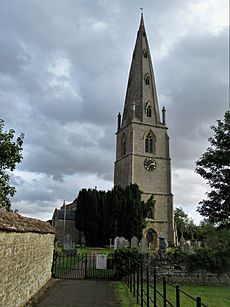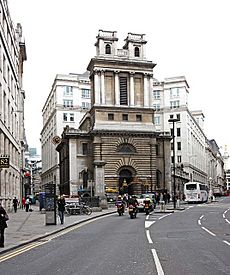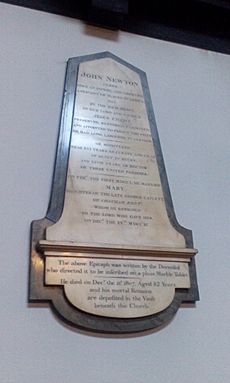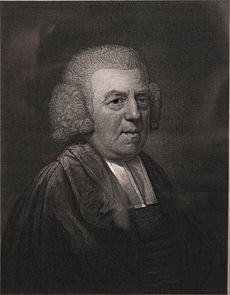John Newton facts for kids
Quick facts for kids John Newton |
|
|---|---|

Contemporary portrait of Newton
|
|
| Personal details | |
| Born | 4 August [O.S. 24 July] 1725 Wapping, London, Great Britain |
| Died | 21 December 1807 (aged 82) London, United Kingdom |
| Spouse |
Mary Catlett
(m. 1750; died 1790) |
| Occupation | British sailor, slaver, Anglican cleric and prominent slavery abolitionist |
John Newton (born August 4, 1725 – died December 21, 1807) was an English Anglican cleric and a strong supporter of ending slavery. He was once a captain of ships that transported enslaved people and also invested in the slave trade. He even served in the Royal Navy and was himself enslaved for a time in West Africa. John Newton is famous for writing the well-known hymns Amazing Grace and Glorious Things of Thee Are Spoken.
Newton started working on ships at a young age, including slave ships, for several years. In 1745, he became enslaved by Princess Peye of the Sherbro people in what is now Sierra Leone. After being rescued, he returned to sea and became a captain of slave ships. Even after he stopped sailing, he continued to invest in the slave trade. However, after a powerful conversion to Christianity, Newton later spoke out against the slave trade. He became a priest in the Church of England and served as a parish priest in Olney, Buckinghamshire, for twenty years, where he wrote many hymns.
Newton lived long enough to see the British Empire make the African slave trade illegal in 1807, just a few months before he passed away.
Contents
John Newton's Early Life
John Newton was born in Wapping, London, in 1725. His father, John Newton the Elder, was a shipmaster who sailed in the Mediterranean Sea. His mother, Elizabeth, came from a family that did not follow the official Church of England. She died from tuberculosis in July 1732, when John was almost seven years old. Newton spent two years at a boarding school before moving to Aveley in Essex to live with his father's new wife.
At age eleven, he began sailing with his father. Newton made six voyages before his father retired in 1742. At that time, his father planned for him to work on a sugarcane plantation in Jamaica. But Newton chose to join a merchant ship sailing to the Mediterranean Sea instead.
In 1743, while visiting friends, Newton was forced to join the Royal Navy. This was called "impressment." He became a midshipman on HMS Harwich. At one point, Newton tried to run away and was punished severely in front of the whole crew. He was whipped and lost his rank, becoming a common sailor.
After this difficult experience, Newton thought about drastic actions. But he recovered both physically and mentally. Later, while Harwich was sailing to India, he moved to Pegasus, a slave ship heading to West Africa. This ship carried goods to Africa to trade for enslaved people, who were then taken to colonies in the Caribbean and North America.
Enslavement and Rescue in Africa
Newton did not get along with the crew of Pegasus. In 1745, they left him in West Africa with Amos Clowe, a slave dealer. Clowe then gave Newton to his wife, Princess Peye of the Sherbro people. She treated Newton poorly, just like her other enslaved people. Newton later described this time as when he was "a servant of slaves in West Africa."
In early 1748, a sea captain rescued him. This captain had been asked by Newton's father to search for him. Newton returned to England on the merchant ship Greyhound, which was carrying beeswax and wood used for dyes.
John Newton's Spiritual Change

In 1748, during his journey back to England on the ship Greyhound, Newton had a life-changing spiritual experience. He woke up to find the ship caught in a terrible storm off the coast of County Donegal, Ireland, and it seemed like it would sink. Newton began to pray for God's help, and soon after, the storm began to calm down. After four weeks at sea, the Greyhound finally reached port in Lough Swilly, Ireland. This event marked the beginning of his journey toward Christianity.
He started reading the Bible and other Christian books. By the time he reached Britain, he had accepted the ideas of evangelical Christianity. He always remembered March 10, 1748, as the date this change began. From then on, he stopped using bad language, gambling, and drinking. Even though he continued to work in the slave trade for a while, he had started to feel sympathy for the enslaved people during his time in Africa. He later said that his true and complete conversion happened some time after this event.
Involvement in the Slave Trade
Newton returned to Liverpool in 1748, which was a major port for the Triangle Trade. With help from his father's friend, Joseph Manesty, he became the first mate on the slave ship Brownlow. This ship sailed to the West Indies by way of the coast of Guinea. After returning to England in 1750, he made three voyages as captain of the slave ships Duke of Argyle (1750) and African (1752–53 and 1753–54). After suffering a serious stroke in 1754, he stopped sailing but continued to invest money in Manesty's slave trading businesses.
Later, after Newton moved to London to become the rector of St Mary Woolnoth Church, he joined the Committee for the Abolition of the Slave Trade, which was formed in 1787. During this time, he wrote a powerful pamphlet called Thoughts Upon the African Slave Trade. In it, he wrote: "It will always be a subject of humiliating reflection to me, that I was once an active instrument in a business at which my heart now shudders." He sent copies to every Member of Parliament, and the pamphlet was so popular it had to be reprinted quickly.
Marriage and Family Life
On February 12, 1750, John Newton married his childhood sweetheart, Mary Catlett. Their wedding took place at St. Margaret's Church, Rochester.
Newton and Mary also adopted his two orphaned nieces, Elizabeth Cunningham and Eliza Catlett, who were from Mary's side of the family.
Becoming an Anglican Priest
In 1755, Newton became a tax collector at the Port of Liverpool, again with help from Manesty. In his free time, he studied Greek, Hebrew, and Syriac, preparing for serious religious study. He became well known as a lay minister, meaning he preached without being an ordained priest. In 1757, he applied to become a priest in the Church of England, but it took more than seven years for him to be accepted.
Finally, in 1764, he was introduced to The 2nd Earl of Dartmouth, who helped recommend Newton to the Bishop of Chester. Newton was suggested for the church position in Olney, Buckinghamshire. On April 29, 1764, Newton became a deacon, and then he was officially ordained as a priest on June 17.
As the curate of Olney, Newton received support from John Thornton, a wealthy merchant and Christian giver. Thornton added to Newton's yearly salary to help him with hospitality and to assist the poor. Newton quickly became known for his care for his community and for his strong beliefs. His friendships with different Christian groups meant he was respected by both Anglicans and Nonconformists. He spent sixteen years in Olney. His sermons were so popular that the church had to add a gallery to make room for all the people who came to hear him.
In 1779, John Thornton invited Newton to become the Rector of St Mary Woolnoth, on Lombard Street in London. He served there until his death. Newton was one of only two evangelical Anglican priests in London, and he quickly became popular among the growing evangelical movement. He strongly supported evangelicalism within the Church of England. He remained friends with various Christian groups, including Methodists and Baptists, as well as Anglicans.
Many young churchmen and people struggling with their faith sought his advice. This included famous figures like the writer Hannah More and the young William Wilberforce, a member of parliament (MP). Wilberforce had recently had a spiritual conversion and was thinking about leaving politics. He talked to Newton, who encouraged him to stay in Parliament and "serve God where he was."
In 1792, Newton received an honorary degree from the College of New Jersey (now Princeton University).
Writer and Hymn Writer
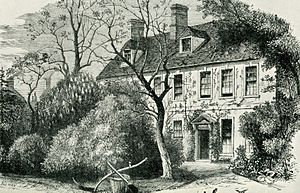
In 1767, William Cowper, a poet, moved to Olney. He attended Newton's church and worked with the priest on a book of hymns. This book, called Olney Hymns, was published in 1779. It had a big impact on English hymn writing. The book included Newton's famous hymns like "Glorious Things of Thee Are Spoken," "How Sweet the Name of Jesus Sounds!," and "Faith's Review and Expectation," which is now known as "Amazing Grace".
Many of Newton's hymns are still used today, especially in the Sacred Harp, a hymnal used in the American South. These hymns were written for shape note singing, which made them easy to learn and allowed people to sing in four-part harmony. This type of music was very popular with Christian preachers who wanted to reach new people.
Newton also wrote an autobiography called An Authentic Narrative of Some Remarkable And Interesting Particulars in the Life of ------. He published it anonymously in 1764. It was later described as being "written in an easy style, distinguished by great natural shrewdness."
Abolitionist Efforts
In 1788, 34 years after he had stopped working in the slave trade, Newton finally spoke out about it. He published a strong pamphlet called Thoughts Upon the Slave Trade. In it, he described the terrible conditions on slave ships during the Middle Passage, the journey across the Atlantic Ocean. He apologized, saying it was "a confession, which... comes too late." He added that it would "always be a subject of humiliating reflection to me, that I was once an active instrument in a business at which my heart now shudders." He sent copies to every Member of Parliament, and the pamphlet sold so well that it quickly needed to be reprinted.
Newton became a close friend and supporter of William Wilberforce, who led the effort in Parliament to end the African slave trade. Newton lived to see the British Parliament pass the Slave Trade Act 1807, which made the slave trade illegal.
Newton came to believe that during the first five of his nine years as a slave trader, he had not been a true Christian. In 1763, he wrote: "I cannot consider myself to have been a believer in the full sense of the word, until a considerable time afterwards."
Final Years and Legacy
Newton's wife, Mary Catlett, died in 1790. After her death, he published Letters to a Wife (1793), where he shared his deep sadness. Newton suffered from poor health and failing eyesight in his later years. He died on December 21, 1807, in London. He was buried next to his wife in St. Mary Woolnoth in London. Later, in 1893, both were reburied at the Church of Saints Peter and Paul, Olney.
Remembering John Newton

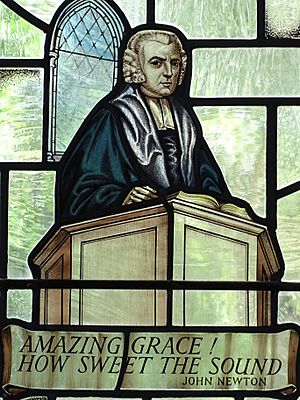
- When he was first buried in London, a memorial plaque with his own words was placed on the wall of St Mary Woolnoth.
- Newton is also remembered on his tomb in Olney with an epitaph he wrote himself. It says he was "Once an infidel and libertine a servant of slaves in Africa was by the rich mercy of our LORD and SAVIOUR JESUS CHRIST preserved, restored, pardoned and appointed to preach the faith he had long laboured to destroy."
- The town of Newton in Sierra Leone is named after him. To this day, his former town of Olney provides help and support to the African town.
- In 1982, Newton was recognized for his important hymns by the Gospel Music Association. He was inducted into the Gospel Music Hall of Fame.
- A memorial to him was built in Buncrana in County Donegal, Ireland, in 2013.
John Newton in Media
Films
- The film Amazing Grace (2006) shows how Newton influenced William Wilberforce. Albert Finney plays Newton in this movie.
- The Nigerian film The Amazing Grace (2006) tells the story of the slave trade from an African point of view. Nick Moran plays John Newton in this film.
- The 2014 film Freedom includes a story about John Newton (played by Bernhard Forcher) as the captain of a slave ship. It also explores his spiritual conversion.
Stage Shows
- African Snow (2007) is a play about John Newton's thoughts. It was first performed in York and later in London.
- The musical Amazing Grace tells the story of Newton's life.
Television
- Newton is played by actor John Castle in the British TV miniseries, The Fight Against Slavery (1975).
Books
- Caryl Phillips' novel, Crossing the River (1993), uses parts of Newton's own writings from his time as a slave trader.
- In the novel Jerusalem by Alan Moore (2016), a character learns about Newton's life and his involvement in the slave trade, which makes him think deeply about the hymn "Amazing Grace."
See also
 In Spanish: John Newton para niños
In Spanish: John Newton para niños


